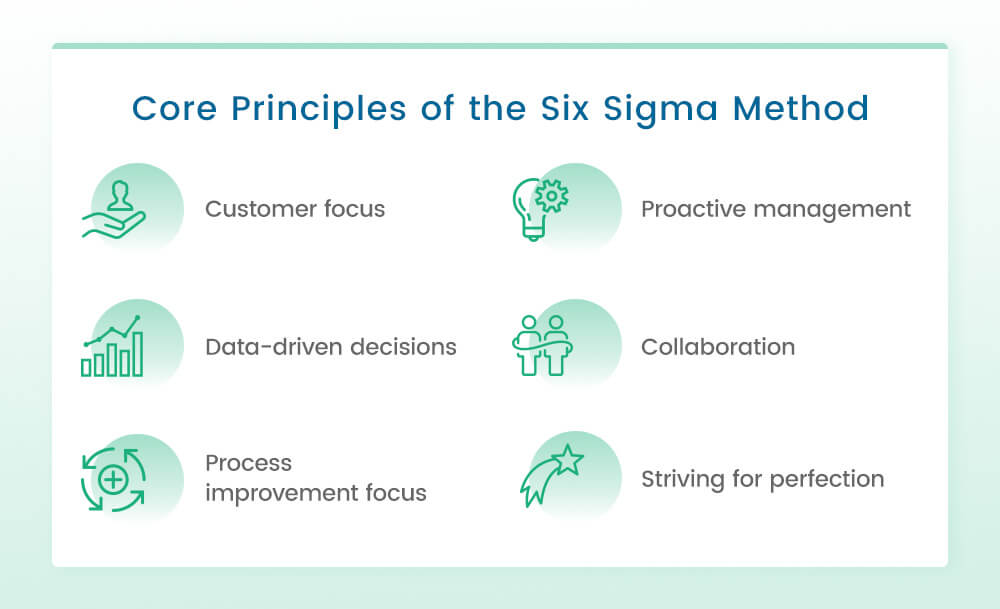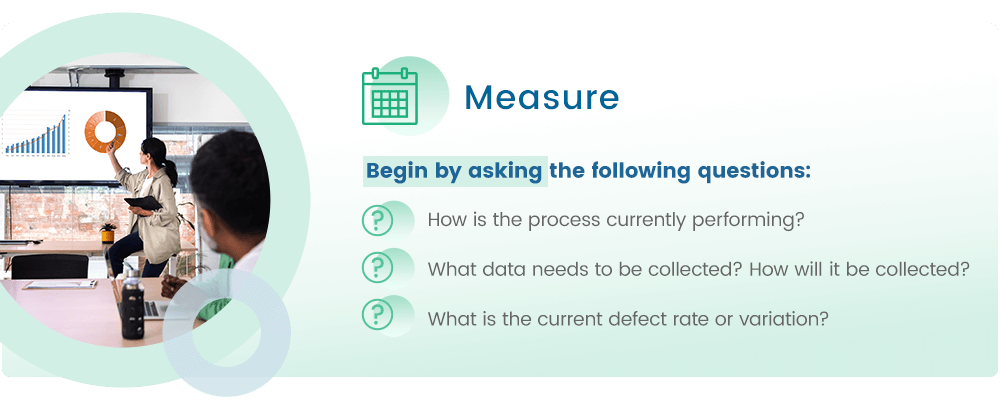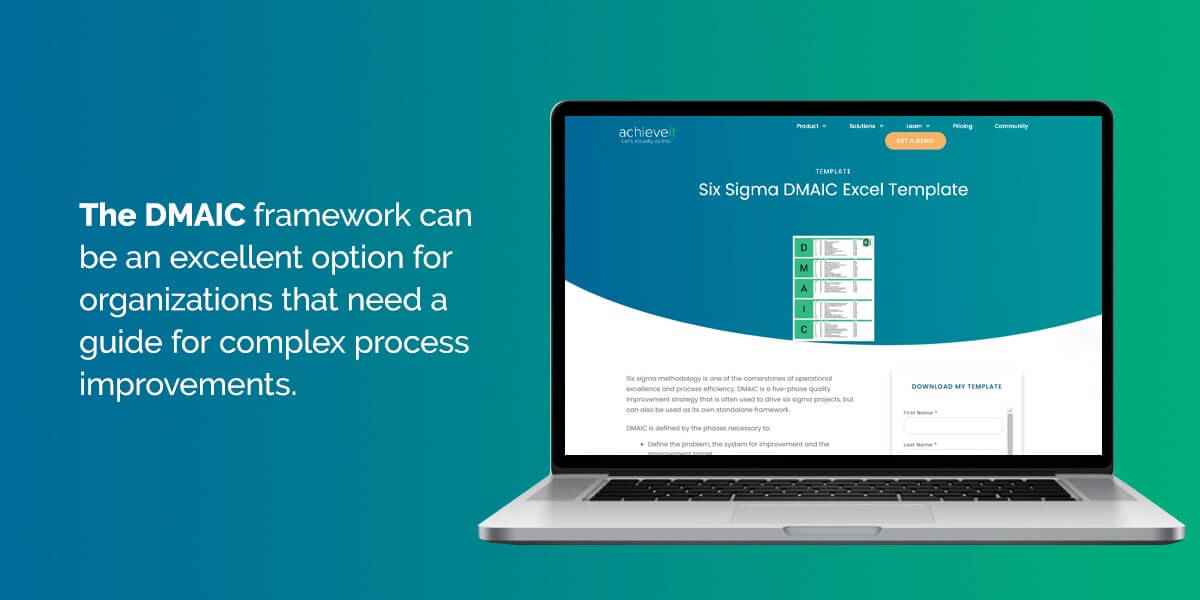Workplace inefficiencies are one of the biggest challenges facing modern businesses. Over time, they can significantly harm your overall performance and profits while weakening your position in the marketplace. Combating these inefficiencies is at the front of many business managers’ minds, but they can be hard to identify.
Luckily, the Six Sigma methodology is all about identifying workplace inefficiencies and identifying newer, better strategies for your business. It is a measurement-based strategy for process improvement and quality management. The approach is based on a straightforward philosophy — by identifying, measuring and analyzing critical metrics of your business processes, you can find ways to improve those processes and drive better results. The goal? Reduce defects to 3.4 for every million opportunities your business has.
This approach to process improvement was formulated by a Motorola engineer named Bill Smith in 1985. It then exploded in popularity when General Electric CEO Jack Welch adopted it in the 1990s, making it the foundation for a culture of growth and improvement at General Electric.
This philosophy of growth has two main branches, DMAIC and DMADV, each of which focuses on specific business processes. In this article, we examine DMAIC, which is dedicated to improving existing business processes.
Want to know how you can incorporate this methodology into your organization? Read on.
In This Article
- Core Principles of the Six Sigma Method
- What Is the DMAIC Methodology and Why Is It Important?
- How to Outline the DMAIC Phases
- Benefits of Implementing the Six Sigma DMAIC Process
- Connecting DMAIC to Strategy Execution
- Why Use a DMAIC Template?
Core Principles of the Six Sigma Method

Both DMAIC and DMADV are governed by the following six principles:
- Customer focus: All processes should be understood through the lens of the customer experience, as they are Critical to Quality (CTQ). Any changes made should improve that experience.
- Data-driven decisions: All process changes should be based on data and statistical analysis rather than assumptions or preconceptions. This approach increases the likelihood that the new strategy will be successful and minimizes time spent testing methods that have not been proven.
- Process improvement focus: Every step of the Six Sigma method should focus on reducing waste and variation across business practices. Improvement and efficiency are always the end goals.
- Proactive management: Stakeholders must actively look for defects and inefficiencies. Waiting for problems to arise and allowing bad habits to form will make it harder for everyone to adapt in the future.
- Collaboration: All process changes should result from teamwork and open discussion. Stakeholders across a range of levels can offer unique insights into business practices that others may have missed, making them invaluable assets when planning process improvement and quality management.
- Striving for perfection: Every stakeholder must strive for perfection while acknowledging the realistic limitations of business processes. Steady improvement should be the goal rather than perfect efficiency.
What Is the DMAIC Methodology and Why Is It Important?
The DMAIC methodology is a Six Sigma framework that involves collecting and analyzing process data to identify improvement opportunities and develop appropriate solutions.
DMAIC is an excellent methodology for complex or high-risk problems. Its rigid structure prevents users from cutting corners and skewing the data, which can damage your chances of success. It also allows for continuous improvement because companies can adjust the approach to apply lessons learned in previous studies.
That said, DMAIC is too detailed for low-risk situations with obvious solutions. Another methodology would be more fitting for these circumstances.
How to Outline the DMAIC Phases
DMAIC stands for Define, Measure, Analyze, Improve and Control. Each phase is critical to a successful process change, so be sure you thoroughly complete each step before moving forward.
D: Define
You begin the process by defining the problem you want to solve and your plan for solving it. Here’s what your summary should include:
- Problem statement
- Project scope
- Goal statement
- Business case
- Team responsibilities
- Important milestones
- Benefits
Remember that DMAIC studies are top-down processes, so you’ll need top management and other business leaders to sign off on your project. The summary you create in this phase can help you justify your case and win the necessary approval.
Here are some key questions your summary should answer:
- What problem are we trying to solve?
- Who are the customers, and what are their needs?
- What are the project boundaries and deliverables?
Some common tools used in this phase are:
- Project Charter to define scope, objectives and team members
- Voice of the Customer (VOC) analysis in the form of surveys and interviews
- A Suppliers, Inputs, Process, Outputs and Customers (SIPOC) Diagram
M: Measure
Next, you’ll need to determine how you will measure your progress.

Begin by asking the following questions:
- How is the process currently performing?
- What data needs to be collected? How will it be collected?
- What is the current defect rate or variation?
Collecting good data is critical for a successful DMAIC study. The parameters you choose to quantify should be relevant to the scope and nature of your project and directly relate to the problem you are trying to solve.
You should also use suitable data collection methods to ensure you gather enough data. Some options include:
- Process flowcharts
- Run charts
- Measurement system analysis (MSA)
- Gage repeatability and reproducibility (Gage R&R)
- Defects per million opportunities (DPMO)
- Process Sigma
- Benchmarking
- Process capability analysis
One quick note on measurement methodology. Be aware of how the mere measurement effect can influence the data you collect. According to this psychological theory, when people know they are under observation, they unconsciously change their behavior — this can significantly influence your data.
You can account for the mere measurement effect by extending the measurement phase and collecting more data. The information you gather at the beginning of this phase is the most likely to be affected, so you can ignore your first few observations.
A: Analyze
Once you’ve collected all your data, it’s time to interpret it. The goal of this phase is to identify and understand the gaps between ideal and actual performance and find opportunities for improvement.
Some key questions you should ask in this phase include:
- What are the underlying reasons for defects or variation?
- Which inputs or process steps have the biggest impact?
- What part of the process represents the greatest opportunity for efficiency improvements?
Using the right statistical tools to plot and visualize your data will help your interpretation. Some particularly helpful examples include:
- Histograms
- Time series plots
- Scatter plots
- Cause and effect diagrams
- 5 Whys
- Pareto chart
- Hypothesis testing through regression analysis or analysis of variance (ANOVA)
- Failure modes and effects analysis (FMEA)
Some of these tools will make more sense for your processes than others — make sure you choose the correct method for your application to ensure accurate interpretations.
I: Improve
The insights you gained during the Analyze phase will inform the steps you take in the Improve phase. Now that you’ve identified opportunities for improving your processes, it’s time to implement those improvements.
Start by asking questions such as:
- What are potential solutions?
- How can we test these solutions on a small scale?
- Which solution is most effective and feasible?
Then, work with process owners and other relevant stakeholders to draft an action plan. Oftentimes, this planning process is supported by methods and tools like:
- Brainstorming
- Design of experiments (DOE)
- Pilot testing
- Mistake-proofing, or Pake-Yoke
- FMEA, which is used in this phase to assess new risks introduced by the action plan
Once it’s completed, the action plan should specify:
- The changes you plan to implement
- Who is responsible for making these changes
- When these changes will be implemented
After finalizing your action plan, you need to set it in motion. Implement all the changes outlined in your plan, and test periodically to monitor their effectiveness.
C: Control
The Control phase is potentially the most critical phase of a DMAIC study because it ensures sustained performance. After all, why go to the trouble of launching the study if you don’t continue the improvements you made?
This phase often encompasses the transition from your organization’s existing processes to the new practices you defined in the Improve phase.
As you’re planning this transition, you should ask the following questions:
- How will we maintain the gains produced by the action plan?
- What monitoring systems need to be in place?
- How will the new process be documented?
One of the best ways to ensure success is to train all your relevant stakeholders on the improvements you implemented. Your stakeholders can then understand how the processes have changed and what they should do to continue supporting the improvements.
Many businesses adopt one or more of the following tools to make adhering to the new processes easier:
- Statistical process control (SPC) charts
- Standard operating procedures (SOPs)
- Monitoring plans
- Process dashboards
Some useful tools for tracking the success of these changes include:
- Flowcharts
- Cost savings calculations
- Process Sigma calculations
Benefits of Implementing the Six Sigma DMAIC Process
When implemented correctly, the DMAIC methodology in Six Sigma brings many benefits to your business. They include:
- Reduced costs
- Reduced rate of defects
- Better data-driven decision-making
- Improved efficiency and productivity
- Increased customer satisfaction and loyalty
- Enhanced employee engagement and problem-solving skills
- Stronger alignment of operational improvements with strategic goals
Together, these benefits can improve business operations at all levels.
Connecting DMAIC to Strategy Execution

Projects and processes supercharged by DMAIC do more than just resolve workplace inefficiencies — they move your business closer to its broad strategic objectives. By increasing output and improving internal collaboration and the customer experience, DMAIC combats process issues and empowers your business to grow into its potential. Whether you’re seeking a stronger position in the market or a reduction in waste, DMAIC can make your strategic goals a reality.
To reach those goals, however, you’ll need to identify inefficiencies and track your implementation of the Six Sigma methodology. Using a DMAIC template can help you do just that.

Why Use a DMAIC Template?
Organizations need a formalized document to guide them through the Six Sigma process and compile all the necessary information that will allow them to properly implement this framework. Setting up a DMAIC document yourself is a time-consuming, inefficient process, which is the exact opposite of what the framework stands for.
That’s what makes a DMAIC template so useful. A DMAIC template includes headers for each phase and space to include all the information and observations gathered during the process. Having this document at the ready makes getting started quick and easy — all you need to do is save a copy, and you’re good to go.
Other benefits of using a DMAIC template include:
- Improved consistency: When you use the same format for your DMAIC studies, you make your data easier to understand for all your stakeholders and team members.
- Enhanced productivity: When you find ways to remove inefficiencies and streamline your processes, you’ll increase throughput and boost overall productivity.
- Better results: The great thing about a template is that you can optimize the process by changing the template after each study to reflect what you learned.
Common Use Cases for the DMAIC Template
One of the DMAIC methodology’s top advantages is its versatility — organizations across various industries can adopt the framework to solve inefficiencies. The Six Sigma approach can be used for the following applications:
- Manufacturing: The repetitive nature of most assembly line jobs presents ample opportunities for data collection. By monitoring key metrics like production output and occurrence of defects, you can find ways to improve employee productivity, product consistency and overall profitability.
- Company culture: Human resources teams can use the DMAIC framework to improve their workplace culture. With input gained from employee complaints and suggestions, HR can identify how their current culture deviates from the company mission and brainstorm appropriate solutions.
- Sports: It may seem like an unlikely example, but athletes and coaches can use the DMAIC framework to identify and solve performance issues. This approach works best for individual sports because there are fewer variables to account for, but it can also be applied to some team sports.

Let’s Actually Do This
The DMAIC framework can be an excellent option for organizations that need a guide for complex process improvements. Our platform is methodology-agnostic, so it’s flexible to any organization’s planning style. Download our DMAIC template to get started.
See for yourself how partnering with AchieveIt can drive better organizational results and improve your strategy execution. Contact us today to request a live demo.



